#America's test kitchen
Text
How to Make Ultracreamy Hummus
youtube
❤️ 😋
2 notes
·
View notes
Text

America's Test Kitchen choosing violence
4 notes
·
View notes
Text
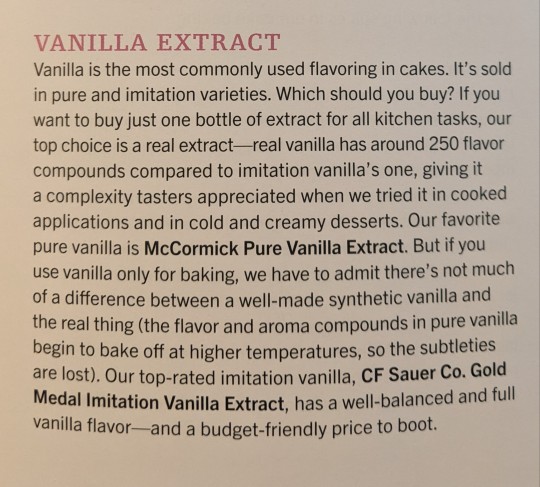
From The Perfect Cake, (c) 2018 America's Test Kitchen.
4 notes
·
View notes
Text
Ice Cream Sundae Board

Serves 4 to 6
Start with:
Ice cream
Sprinkles
Candy toppings (M&M’s, gummy bears, mini chocolate chips, mini marshmallows, mini peanut butter cups)
Maraschino cherries
Classic Hot Fudge Sauce (store bought or recipe below)
Whipped Cream (recipes below)
If you want, add:
Salted Butterscotch Sauce (recipe below)
Mixed Berry Coulis (recipe below)
More toppings (crushed up chocolate and/or plain ice cream cones, crumbled Oreos)
Waffles (store-bought)
Bananas
Ice Cream Sundaes
The headnote says, “Ice cream is a food stylist’s worst nightmare: It melts at lightning speed on set, so you’ve only got a tiny window of time to get that perfect shot. But that doesn’t stop me from flexing my sundae skills at home. For flavors, make sure you’ve got the classics (chocolate and vanilla never fail) but I like to mix in some funky flavors, too, like this beet-chocolate masterpiece from my friend and colleague Jackie Gochenouer’s ice cream business. And who could say no to a waffle sundae like they do at Disney?
Elle’s Strategy:
Set up shop. Put your toppings in small bowls and each sauce in something that’s easy to pour from. Corral everything on a tray, but don’t worry about where the ice cream will go—keeping it separate makes things easier. Set out scoops (owning at least two lets you scoop and fill bowls twice as fast), bowls, and spoons. Save the ice cream for last, and just do a few pints. When they start to get soupy, switch them out for backups from the freezer.
Get a head start. Clear out your freezer to make room for all that ice cream (plan on about 1/2 pint per person, or more if you want more selection). Make your sauces ahead of time; the hot fudge sauce is good for a month! You can even prep your toppings—just cover the dishes in plastic wrap.
Think outside the box. Don’t be afraid to lean into non-sweet toppings. Try cereals, crumbled potato chips, balsamic reduction (see page 148 in book), candied bacon (see page 72 in book), or even flake sea salt (so good with pecan ice cream).
The perfect scoop. Put your scoops in mugs of water. This makes it easier to scoop but also keeps you from double dipping and mixing up the ice cream flavors.
Pints aplenty. If I buy bigger containers of ice cream, I like to repack it into smaller containers to help keep things as cold as possible. You can find empty pints online, but Tupperware works just fine.
Classic Hot Fudge Sauce
Makes about 2 cups
Nothing on earth is better than rich, chocolaty hot fudge sauce, and this recipe is the chocolatiest thanks to the cocoa powder–unsweetened chocolate combo. Using milk, rather than cream, helps preserve that intense chocolate flavor, and incorporating cold butter creates a thick consistency and makes the sauce nice and glossy.
1 ¼ cups (8 ¾ ounces) sugar
2/3 cup whole milk
¼ teaspoon table salt
1/3 cup (1 ounce) unsweetened cocoa powder, sifted
3 ounces unsweetened chocolate, chopped fine
4 tablespoons unsalted butter, cut into 8 pieces and chilled
1 teaspoon vanilla extract
1. Heat sugar, milk, and salt in medium saucepan over medium-low heat, whisking gently, until sugar has dissolved, and liquid starts to bubble around edges of saucepan, about 6 minutes. Reduce heat to low, add cocoa, and whisk until smooth.
2. Off heat, stir in chocolate and let sit for 3 minutes. Whisk sauce until smooth and chocolate is fully melted. Whisk in butter and vanilla until fully incorporated and sauce thickens slightly. (Sauce can be refrigerated for up to 1 month; gently warm in microwave before using, stirring every 10 seconds, until pourable.)
Variation
Chocolate-Tahini Sauce
Add 1/3 cup tahini with the butter and vanilla.
Whipped Cream
Makes about 2 cups
A dollop of whipped cream is always the right sundae move. Where else would that cherry perch? This recipe is so much better than the canned stuff, and the flavor variations add a unique twist your guests won’t see coming (hello, brown sugar and bourbon).
1 cup heavy cream, chilled
1 tablespoon sugar
1 teaspoon vanilla extract
Pinch table salt
Using stand mixer fitted with whisk attachment, whip cream, sugar, vanilla, and salt on medium-low speed until foamy, about 1 minute. Increase speed to high and whip until soft peaks form, 1 to 3 minutes. (Whipped cream can be refrigerated in fine-mesh strainer set over small bowl and covered with plastic wrap for up to 8 hours.)
Variations
Maple Whipped Cream
Substitute 2 tablespoons maple syrup for sugar. Reduce vanilla to 1/2 teaspoon.
Brown Sugar and Bourbon Whipped Cream
Omit vanilla. Substitute 1/2 cup packed light brown sugar for granulated sugar. Increase salt to 1/8 teaspoon. Add 1/2 cup sour cream and 2 teaspoons bourbon. Before whipping, whisk all ingredients together in bowl of stand mixer, cover with plastic wrap, and refrigerate for at least 4 hours, or up to 24 hours. Whisk again to combine before whipping.
Orange Whipped Cream
Substitute 2 tablespoons orange juice for vanilla. Add 1 teaspoon grated orange zest to stand mixer with cream before whipping.
Peanut Butter Whipped Cream
Add 1/4 cup creamy peanut butter to stand mixer with cream before whipping. Once mixture is foamy, continue to whip on medium-low speed until soft peaks form, 1 to 3 minutes.
Level Up Your Board
Salted Butterscotch Sauce
Makes about 1 ½ cups
This is so much easier than making a caramel sauce, and it’s just as delicious—if not more so; the salty-sweet combo is killer. Do yourself a favor and make a little extra to drizzle over pie, bread pudding, or cake.
1 cup packed (7 ounces) light brown sugar
1/2 cup heavy cream
8 tablespoons unsalted butter, cut into 8 pieces and chilled, divided
½ teaspoon table salt
½ teaspoon vanilla extract
1. Combine sugar, cream, 4 tablespoons butter, and salt in medium saucepan. Cook over medium-high heat, stirring often with rubber spatula, until large bubbles burst on surface of sauce, about 4 minutes. Remove from heat.
2. Carefully stir in vanilla and remaining 4 tablespoons butter until fully combined, about 1 minute. Carefully transfer sauce to bowl and let cool for 30 minutes (sauce will thicken as it cools). Serve. (Sauce can be refrigerated for up to 1 week. Reheat in microwave before serving.)
Mixed Berry Coulis
Makes about 1 ½ cups
The type of berries used as well as their ripeness will affect the sweetness of the coulis, so the amount of sugar is variable. Start with 5 tablespoons, then add more to taste in step 2. Additional sugar should be stirred into the warm coulis immediately after straining so that the sugar will readily dissolve.
15 ounces (3 cups) fresh or thawed frozen blueberries, blackberries, and/or raspberries
¼ cup water
5 tablespoons sugar, plus extra for sweetening
1/8 teaspoon table salt
2 teaspoons lemon juice
1. Bring berries, water, sugar, and salt to gentle simmer in medium saucepan over medium heat and cook, stirring occasionally, until sugar is dissolved, and berries are heated through, about 1 minute.
2. Process mixture in blender until smooth, about 20 seconds. Strain through fine-mesh strainer into bowl, pressing on solids to extract as much puree as possible; discard solids. Stir lemon juice into puree and sweeten with extra sugar as needed. Cover and refrigerate until well chilled, about 1 hour. Adjust consistency with extra water as needed. (Sauce can be refrigerated for up to 4 days; stir to recombine before using.)
Get Even:
Say goodbye to soupy tops and rock-solid centers. For evenly defrosted pints, don’t go straight from the freezer to counter. Instead, put the pints in the refrigerator for 30 minutes. Why? The greater the disparity between the temperature of the food and the temperature of the air around it, the more unevenly it warms up. The refrigerator tempers the ice cream, ensuring it defrosts evenly all the way through.
Spruce up store-bought Hot Fudge:
Nothing beats homemade, but if you’re popping open a jar instead, there are some things you can do to add a little pizzazz.
Spice it up with a sprinkle of ground cardamom, cinnamon, ginger, or even cayenne or curry powder.
Add a splash of mint, vanilla, almond, coconut, or anise extract.
Get boozy with some Grand Marnier, Chambord, or Kahlúa liqueur.
Catch a buzz by stirring in some instant espresso or matcha powder.
Recipes and images courtesy of “Board’s: Stylish Spreads for Casual Gatherings” America’s Test Kitchen

4 notes
·
View notes
Text
Popularity of grains, beans is growing

While dining out during a recent trip, I noticed that the restaurants had several dishes where beans and grains were mentioned in the item’s name or description. Looking at some old menus in my archives, it was rare to see items with beans and grains mentioned. Today, in the United States, their popularity is growing by leaps and bounds.
There are many reasons: health benefits, affordability, interest in plant-based diets, cultural influences, many grains are gluten-free, sustainability and versatility.
Talking about versatility; brownies made with black beans (they’re quite good, and people won’t know what the secret ingredient is), burgers made with a variety of beans, bean-based dips (have you tried a dessert hummus with chocolate as an ingredient?), grains in salads and soups, grains such as quinoa and oats in smoothies as well as grains and beans in those popular breakfast and lunch bowls.
All it takes is creativity to prepare nutritious and flavorful dishes using beans and grains in recipes.
A staple in many cuisines around the globe, especially China, Mexico, India and Brazil, beans and grains have been nourishing the world for thousands of years.
Did you know?
• Lentils were eaten 13,000 years ago in the Middle East.
• Beans are considered symbols of good luck and prosperity in many cultures. In regions in the United States, it is customary to eat black-eyed peas on New Year’s Day. They are eaten at Rosh Hashana, the Jewish New Year as a symbol of a prosperous year ahead. A good friend from Brazil prepares lentils on New Year’s Eve, symbolizing wealth and good fortune, his culture’s tradition he continues here in the U.S.
• Beans come in all shapes, colors and sizes, and come in thousands of varieties.
• Quinoa (a complete protein on its own), farro, spelt and amaranth are ancient grains that have gained popularity due to their health and nutritional benefits. They were part of the diet of ancient civilizations. Everything old is new again!
• Rice, millet, sorghum, buckwheat and rice are among the gluten-free grains, the perfect option for those with diet restrictions.
My goal to include more beans and grains in my diet led me to getting a copy of “The Complete Beans & Grains Cookbook: A Comprehensive Guide with 450+ Recipes,” by the editors of America’s Test Kitchen (2024, $34.99)
And complete it is…. before presenting the recipes, there is an in-depth discussion about beans. You’ll learn about common beans vs. heirloom beans, colors and flavors. There is a compilation of two dozen dried beans used in the recipes. Each bean is discussed in detail, including tasting notes and the recipes they are used in.
From here you’ll master how to cook dried beans resulting in the perfect flavor and texture. For those who prefer to use the convenience of canned beans, that’s covered, too. This is followed by a primer about lentils, a member of the legume family as well as other legumes such as fava beans, green beans, peanuts and soybean varieties.
Then, it’s onto grains: common, whole and heirloom. Twenty-one grains are discussed in detail, plus which recipes they are used in. Then, how to cook grains along with a helpful chart to keep handy. The next section is about varieties of rice used in the recipes along with a rice cooking chart. Concluding the introduction is the equipment that was tested by the test kitchen to cook beans, grains and rice.
Along with the signature headnotes, for which America’s Test Kitchen is known, the recipes that call for heirloom bean and grain varieties that might be more difficult to find, and a-bit-more-expensive, substitutions for a common grocery store alternative, are given. In a hurry…recipes that can be prepared in 45 minutes or less are flagged.
The editors said:“ Even if you are an old hand at cooking beans and grains, there are hundreds of inventive recipes waiting for you. There are traditional recipes for Hoppin’ John, Tacu Tacu and Adasi. There are comfort classics including New England Baked Beans, Ribollita and Arroz con Pollo. There are celebratory dinners such as Chickpea Bouillabaisse, Kibbeh bil Sanieh and Plov.
Let’s get started with these recipes ….
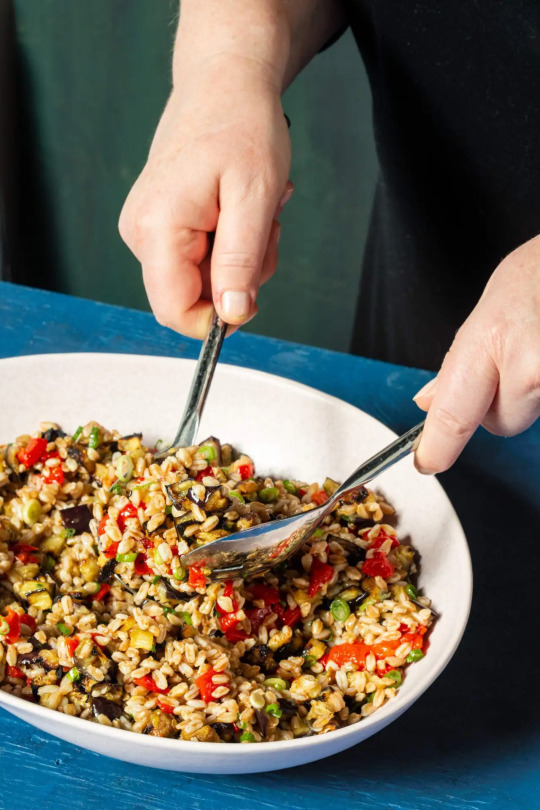
Nutty, earthy farro is one of the fastest-cooking whole grains around, and it works to make the perfect good-for-you Farro Salad With Roasted Eggplant. (Courtesy of America’s Test Kitchen)
Farro Salad with Roasted Eggplant
Serves: 4 to 6
Total time: 1¼ hours
The headnote says: “Why this recipe works: Nutty, earthy farro is one of the fastest-cooking whole grains around, and it works to make the perfect good-for-you grain salad. While the farro cooks, we broil cubed eggplant until it’s nice and brown, which brings essential meatiness and savory, caramelized flavor to the salad. A hefty amount of jarred, roasted red peppers add sweetness and extra veggie goodness.
“Once the farro is cooled, we toss everything together with thinly sliced scallions and a lemony dressing that permeates the whole dish. Do not use pearl, quick-cooking, or pre-steamed farro (check the ingredient list on the package to determine this) in place of the whole farro.”
Ingredients:
1½ cups whole farro
½ teaspoon table salt, plus salt for cooking farro
1½ pounds eggplant, cut into ½‑inch pieces
6 tablespoons extra-virgin olive oil, divided
1 teaspoon grated lemon zest plus 1 tablespoon juice
1½ cups jarred roasted red peppers, rinsed, patted dry, and cut into ½‑inch pieces
3 scallions, sliced thin
¼ teaspoon pepper
Directions:
1. Adjust oven rack 4 inches from broiler element and heat broiler. Bring 4 quarts water to boil in large pot. Add farro and 1 tablespoon salt and cook until grains are tender with slight chew, 15 to 30 minutes. Drain farro, spread onto rimmed baking sheet, and let cool for 15 minutes.
2. Meanwhile, toss eggplant with 3 tablespoons oil, then transfer to aluminum foil–lined rimmed baking sheet and spread into even layer. Broil eggplant until well browned, 15 to 17 minutes, stirring halfway through.
3. Whisk remaining 3 tablespoons oil and lemon zest and juice together in large bowl. Add cooled farro, eggplant, red peppers, scallions, pepper, and salt and toss to combine. Season with salt and pepper to taste. Serve.

Buckwheat Tabbouleh features bulgur parsley, mint and chopped tomatoes tossed in a bright lemon vinaigrette, classic Mediterranean tabbouleh has a refreshing flavor profile that makes it a great light side. (Courtesy of America’s Test Kitchen)
Buckwheat Tabbouleh
Serves: 4
Total time: 35 minutes, plus 45 minutes cooling and resting
The headnote says: “Why this recipe works: Featuring bulgur (a product of the wheat berry), parsley, mint and chopped tomatoes tossed in a bright lemon vinaigrette, classic Mediterranean tabbouleh has a refreshing flavor profile that makes it a great light side. To give this classic our own spin, we swap the bulgur for another grain: mild, appealingly earthy, buckwheat groats.
“Because buckwheat contains a fair amount of starch, we make sure to cook it pasta-style in plenty of water; the water washes away the excess starch, producing separate, evenly cooked kernels. For the herbs, we add plenty of fresh, peppery parsley; 1½ cups has just enough of a presence to balance well with ½ cup of fresh mint. To ensure undiluted, bright flavor in the final tabbouleh, we salt the tomatoes to rid them of excess moisture before tossing them into the salad.”
Ingredients:
¾ cup buckwheat groats, rinsed
½ teaspoon table salt, divided, plus salt for cooking buckwheat
3 tomatoes, cored and cut into ½-inch pieces
2 tablespoons lemon juice
Pinch cayenne pepper
¼ cup extra-virgin olive oil
1½ cups minced fresh parsley
½ cup minced fresh mint
2 scallions, sliced thin
Directions:
1. Bring 2 quarts water to boil in large saucepan. Stir in buckwheat and 2 teaspoons salt. Return to boil, then reduce to simmer and cook until tender, 10 to 12 minutes. Drain well. Spread buckwheat on rimmed baking sheet and let cool for 15 minutes. (Buckwheat can be refrigerated in airtight container for up to 2 days.)
2. Meanwhile, toss tomatoes with ¼ teaspoon salt in bowl. Transfer to fine-mesh strainer, set strainer in bowl, and let sit for 30 minutes, tossing occasionally.
3. Whisk lemon juice, cayenne, and remaining ¼ teaspoon salt together in large bowl. Whisking constantly, drizzle in oil.
4. Add drained tomatoes, cooled buckwheat, parsley, mint, and scallions and gently toss to combine. Cover and let sit at room temperature until flavors meld, at least 30 minutes or up to 2 hours. Toss to recombine and season with salt and pepper to taste. Serve.

Corn Pudding is a rustic, souffle-like casserole. (Courtesy of America’s Test Kitchen)
Corn Pudding
Serves: 6 to 8
Total time: 1 hour
The headnote says: “Why this recipe works: Recipes for this rustic, soufflélike casserole, a traditional part of many a Thanksgiving spread, often call for boxed corn muffin mix and canned cream corn, but here we opt for a fresher take. We swap out the creamed corn for frozen corn kernels, which have a better texture and more flavor than canned. To ensure a silky base brimming with the flavor of sweet corn, we buzz some of the kernels with cream in a blender.
“In place of the boxed muffin mix, we simply combine flour, cornmeal, salt, sugar, and a touch of baking soda; for rich flavor and light texture, we add sour cream and melted butter. Baking the mixture for 35 minutes in a 400-degree oven sets the pudding without drying it out.”
Ingredients:
1 pound frozen corn
¾ cup heavy cream
½ cup (2½ ounces) all-purpose flour
⅓ cup (1⅔ ounces) cornmeal
¼ cup (1¾ ounces) sugar
1¼ teaspoons table salt
¼ teaspoon baking soda
1 cup sour cream
6 tablespoons unsalted butter, melted
1 large egg, lightly beaten
Directions:
1. Adjust oven rack to upper-middle position and heat oven to 400 degrees. Grease 8-inch square baking dish. Combine corn and ¼ cup water in microwave-safe bowl. Cover and microwave until corn is tender, about 7 minutes. Drain corn.
2. Combine cream and 1½ cups corn in blender and process until coarse puree forms, about 30 seconds. Whisk flour, cornmeal, sugar, salt, and baking soda together in large bowl. Whisk sour cream, melted butter, egg, pureed corn mixture, and remaining corn together in separate bowl. Whisk sour cream mixture into flour mixture until combined. Transfer batter to prepared dish.
3. Bake until edges of pudding are lightly browned and top is slightly puffed, about 35 minutes. Let cool on wire rack for 10 minutes. Serve warm.
Recipes courtesy of America’s Test Kitchen.

Stephen Fries is professor emeritus and former coordinator of the Hospitality Management Programs at Gateway Community College in New Haven, Conn. He has been a food and culinary travel columnist for the past 16 years and is co-founder of and host of “Worth Tasting,” a culinary walking tour of downtown New Haven. He is a board member of the International Association of Culinary Professionals. Email him at [email protected]. For more, go to stephenfries.com.
0 notes
Text
We've added a new blog post: "Happy π Day!"
Remember to hug the ones you love today…and every day!!
1 note
·
View note
Text
America’s Test Kitchen Stars

Discover America’s Test Kitchen Stars: Culinary Experts Who Inspire
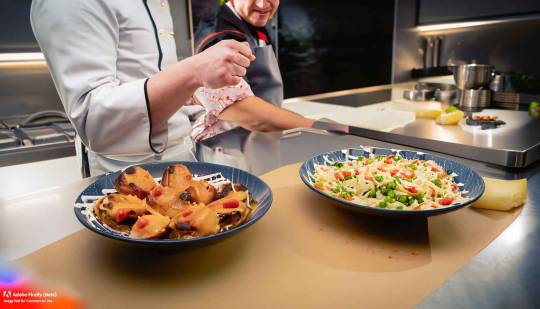
Are you passionate about cooking and constantly seeking inspiration in the culinary world? Look no further than America’s Test Kitchen Stars, a group of exceptional culinary experts who have revolutionized the way we approach cooking and baking. In this article, we will delve into the lives and accomplishments of these talented individuals who have become an integral part of America’s culinary landscape. From their expertise in the kitchen to their influential cookbooks and television shows, let’s explore the fascinating world of America’s Test Kitchen Stars.
Introduction
America’s Test Kitchen has become a renowned culinary institution, and its success can be largely attributed to the talented stars who bring their expertise to the show. In this article, we will explore the remarkable individuals who have graced the kitchen of America’s Test Kitchen and contributed to its popularity. From seasoned chefs to food scientists, these stars have captivated audiences with their culinary skills and passion for cooking.
The Beginnings of America’s Test Kitchen

America’s Test Kitchen was founded in 2000 by Christopher Kimball with the goal of creating a space where cooking enthusiasts could come together to learn and experiment. The show quickly gained popularity due to its rigorous testing methods and unbiased reviews of kitchen equipment and ingredients. Over the years, America’s Test Kitchen has evolved into a powerhouse of culinary expertise, and its stars have played a pivotal role in its success.
Introduction to the Stars
The stars of America’s Test Kitchen are a diverse group of individuals, each bringing their unique talents and backgrounds to the show. From experienced chefs to skilled home cooks, they collectively create a dynamic and informative cooking experience for viewers. Let’s delve into the profiles of these culinary stars and discover what makes them stand out.
Master Chef: Christopher Kimball
Christopher Kimball, the founder of America’s Test Kitchen, is an influential figure in the culinary world. With his iconic bowtie and distinctive voice, he guides viewers through the intricacies of cooking with precision and expertise. Kimball’s passion for exploring the science of cooking and his commitment to teaching others have made him a beloved figure among food enthusiasts.
The Dynamic Duo: Julia Collin Davison and Bridget Lancaster
Julia Collin Davison and Bridget Lancaster are the dynamic duos that bring energy and enthusiasm to America’s Test Kitchen. Their chemistry on screen is palpable, and they have a knack for simplifying complex recipes, making them accessible to viewers of all skill levels. Their friendly banter and practical tips make them fan favorites.
The Science Behind the Food: Dan Souza

Dan Souza, the resident food scientist at America’s Test Kitchen, is known for his meticulous approach to cooking. He delves into the scientific principles behind different cooking techniques, unraveling the mysteries of the culinary world. Souza’s experiments and explanations help viewers understand the “why” behind each step in a recipe.
The Baking Maven: Erin McMurrer
Erin McMurrer is the baking expert at America’s Test Kitchen, specializing in all things sweet and delicious. With her extensive knowledge of baking techniques and her passion for creating the perfect pastry, McMurrer inspires viewers to embrace the joys of baking. Her attention to detail and creative flair make her segments both informative and delightful.
The Tasting Expert: Jack Bishop
Jack Bishop is America’s Test Kitchen’s tasting expert, responsible for evaluating various food products and ingredients. With his discerning palate and vast culinary knowledge, Bishop provides viewers with reliable recommendations and insights into the best brands and flavors. His expertise helps viewers make informed choices when it comes to their own cooking adventures.
The Equipment Guru: Lisa McManus
Lisa McManus, the equipment expert of America’s Test Kitchen, knows all there is to know about kitchen gadgets and appliances. Her thorough testing and reviews help viewers make informed decisions about the tools they need in their kitchens. McManus’s practical advice ensures that home cooks invest in equipment that will truly enhance their culinary endeavors.
The Approachable Cook: Elle Simone
Elle Simone brings warmth and approachability to America’s Test Kitchen. As a seasoned chef, she combines her culinary expertise with a genuine desire to connect with viewers. Simone’s recipes and cooking tips are accessible, making them perfect for home cooks who want to elevate their skills in the kitchen.
The Creative Culinary Director: Becky Hays

Becky Hays, the creative culinary director at America’s Test Kitchen, brings innovation and creativity to the show. Her ability to think outside the box and develop unique recipes keeps the content fresh and exciting. Hays’s contributions ensure that viewers are always inspired to try something new in their own kitchens.
The On-Screen Talent: Adam Ried and Julia Reed
Adam Ried and Julia Reed are the on-screen talents who add flair and personality to America’s Test Kitchen. Their engaging presentations and delightful interactions with the stars and guests create an entertaining and informative viewing experience. Ried and Reed’s contributions contribute to the show’s overall appeal.
The Recipe Developer: Keith Dresser

Keith Dresser, the recipe developer at America’s Test Kitchen, is responsible for creating and testing new recipes. With meticulous attention to detail, Dresser ensures that every recipe is foolproof and delivers outstanding results. His passion for flavor and his dedication to perfecting each dish make him an invaluable asset to the team.
The Editorial Powerhouse: Susannah Gravel
Susannah Gravel, the editorial powerhouse of America’s Test Kitchen, ensures that the content produced meets the highest standards. From overseeing the accuracy of recipes to editing written material, Gravel plays a crucial role in maintaining the integrity and quality of America’s Test Kitchen’s offerings. Her keen eye for detail and commitment to excellence are evident in every aspect of the show.
The Sous Chef Extraordinaire: Ashley Moore
Ashley Moore, the sous chef at America’s Test Kitchen, is responsible for assisting the stars in their culinary endeavors. Her support behind the scenes ensures that everything runs smoothly and that the stars have everything they need to create delicious dishes. Moore’s expertise and dedication are vital to the success of the show.
The Social Media Influencer: Morgan Bolling
Morgan Bolling manages the social media presence of America’s Test Kitchen, connecting with viewers and fans through various online platforms. Her engaging content and behind-the-scenes glimpses provide a deeper connection between the show and its audience. Bolling’s efforts contribute to the show’s expanding reach and influence in the digital realm.
Conclusion
The stars of America’s Test Kitchen bring a wealth of knowledge, passion, and creativity to the show. Through their expertise, they have transformed America’s Test Kitchen into a trusted source of culinary inspiration and education. Whether it’s unraveling the science behind cooking or simplifying complex recipes, these stars have captivated audiences and enriched the culinary experiences of viewers around the world.
FAQs
1. What makes America’s Test Kitchen unique?
America’s Test Kitchen stands out for its rigorous testing methods, unbiased reviews, and focus on the science of cooking. This commitment to excellence sets it apart from other culinary shows.
2. Can I trust the recipes from America’s Test Kitchen?
Absolutely! The recipes from America’s Test Kitchen are meticulously tested to ensure they deliver the best results. You can trust that each recipe has been perfected for home cooks.
3. How can I access America’s Test Kitchen content?
You can access America’s Test Kitchen content through their website, cookbooks, and television show. They also have a membership program that provides exclusive access to additional content and resources.
4. Are the stars of America’s Test Kitchen professional chefs?
Yes, many of the stars of America’s Test Kitchen have professional culinary backgrounds. They bring their expertise from various culinary fields to create exceptional content for the show.
5. Can I interact with the stars of America’s Test Kitchen?
While direct interaction may not be possible, you can engage with the stars through social media platforms and by participating in America’s Test Kitchen’s online community. They often respond to comments and questions from viewers.
6. Can I visit America’s Test Kitchen studios?
Unfortunately, America’s Test Kitchen studios are not open to the public for visits. However, you can experience the magic of the kitchen through their television show and online content.
7. Are there opportunities to participate in America’s Test Kitchen as a guest or contestant?
America’s Test Kitchen occasionally features guests or contestants on their show, but these opportunities are typically limited and selective. Keep an eye on their official website and social media channels for any announcements or casting calls.
8. Are there any live events or cooking demonstrations by the stars of America’s Test Kitchen?
Yes, the stars of America’s Test Kitchen occasionally participate in live cooking demonstrations and events. These events provide a unique opportunity to see them in action and learn from their expertise. Stay updated through their website for information on upcoming events.
9. Can I request specific recipes or topics to be covered by America’s Test Kitchen?
While there is no guarantee that specific requests will be fulfilled, America’s Test Kitchen values viewer feedback and suggestions. You can reach out to them through their website or social media platforms to share your ideas and requests.
10. Are there any educational resources or courses available from America’s Test Kitchen?
Yes, America’s Test Kitchen offers various educational resources, including online cooking courses, instructional videos, and cookbooks. These resources provide in-depth knowledge and hands-on learning opportunities to enhance your culinary skills.
You may like to know more about:
Dash Egg Cooker Instructions
Kitchen Island With Raised Bar Top
Laminate Floors in The Kitchen
If you like reading our articles, you can check our social media or our website for more page links.
Facebook
Connect Us Visit My Website:
Kitchenkosmos - Equipment
#America's Test Kitchen#America's Test Kitchen Recipes#America's Test Kitchen Stars#Kitchen Stars#Master Chef#Stars#Test Kitchen#The Recipe
0 notes
Text
does anyone know of a really good brownie recipe? i prefer fudgy over cakey and that crinkly shiny surface on top but like. i'm not picky.
52 notes
·
View notes
Text

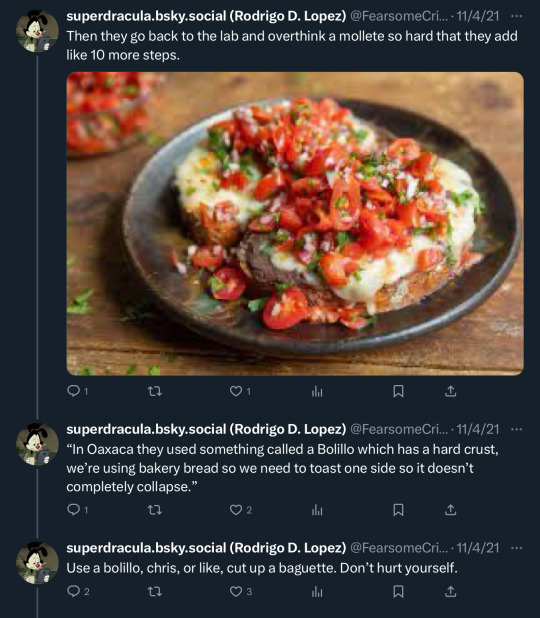

#milk street#america’s test kitchen#rodrigo on twitter#rodrigo on bluesky#bolillo#oaxaca#mexican food
22 notes
·
View notes
Text
Cooking With Christie: The Best Compliment my Bakes have Ever Received!
This Week’s Recipe: Lemon Bars
Inspiration: Sticking with the recent lemon theme, I decided to make some lemon bars for a going away party. And the recipient, who originally hails from Maryland, gave me the best compliment my bakes ever received by calling them, “Slap Your Momma Good!”
She loved them so much that after one taste, she secreted the entire pan away (which was a-o-kay as I’d baked…

View On WordPress
#agatha Christie#america&039;s test kitchen#book#book cover#book photo#book pic#Cooking With Christie#death in the clouds#hercule poirot#lemon bars#my 52 weeks with christie#mystery#Poirot
11 notes
·
View notes
Text
Chili Cheese Dogs

The headnote says, Why This Recipe Works: “Cherry pepper brine added heat and tang to our simple microwave cheese sauce.”
Serves 4
Total Time: 40 minutes
For the best texture, we recommend using American cheese from the deli counter (not individually wrapped slices).
· 1 pound 85 percent lean ground beef
· 2 tablespoons chili powder
· ½ teaspoon table salt
· ½ teaspoon pepper
· ¼ cup tomato paste
· 1 cup water
· 8 ounces deli American cheese, chopped coarse
· ⅓ cup whole milk
· ¼ cup chopped jarred hot cherry peppers, plus 1 tablespoon brine
· 8 hot dogs
· 8 hot dog buns, split
· ¼ cup finely chopped onion
1. Combine beef, chili powder, salt, and pepper in 12-inch nonstick skillet. Cook over medium-high heat, breaking up meat with wooden spoon, until beef is no longer pink, about 6 minutes. Stir in tomato paste and cook until paste begins to darken, about 1 minute. Add water and cook until sauce thickens and coats beef, about 4 minutes. Set aside and cover to keep warm.
2. Meanwhile, microwave American cheese, milk, and cherry pepper brine in bowl until cheese is fully melted, about 3 minutes, stirring occasionally. Cover to keep warm.
3. Split each hot dog lengthwise, stopping short of cutting completely in half, so dogs are hinged on 1 side. Grill dogs over hot fire until well browned, about 2 minutes per side. Grill buns cut side down until toasted, about 1minute. Stir cheese sauce to recombine. Divide hot dogs, chili, and cheese sauce evenly among buns. Top with cherry peppers and onion. Serve.
Recipe and photo provided by America’s Test Kitchen
3 notes
·
View notes
Text
epic high of the day: made VERY GOOD SCONES
epic low of the day: somehow fucked up the back of my throat so had a violent sore throat all day and a covid scare at work
#shining a flashlight at that abrasion like HELLO. HOW DID YOU GET THERE.#.pdf#anyway the scones were so good thank u americas test kitchen cookbook
3 notes
·
View notes
Text
It’s time to talk turkey, and all the trimmings
Check out my latest column
It's time to talk turkey, and all the trimmings (timesherald.com)
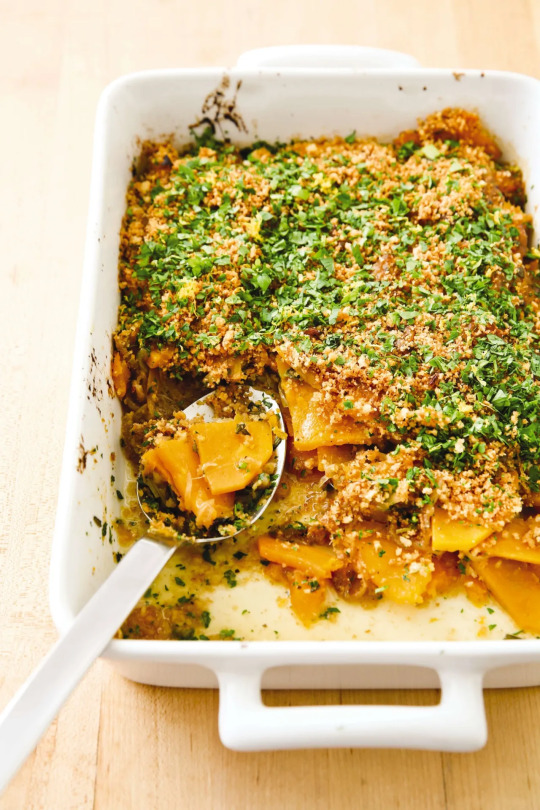
In Butternut Squash Gratin, toasted panko bread crumbs add a nice crunch. (Courtesy of America’s Test Kitchen)
The countdown to Thanksgiving is here, so let’s talk turkey, stuffing, cranberry sauce, sweet potatoes and pumpkin pie.
“Thanksgiving is the meal we aspire for other meals to resemble,” said novelist Jonathan Safran Foer.
Another quote by journalist Nora Ephron: “The turkey. The sweet potatoes. The stuffing. The pumpkin pie. Is there anything else we can agree so vehemently about? I don’t think so.” Great food for thought.
Before I get into the food and recipes, I thought I would share some interesting facts about Thanksgiving. Curious to know how the date came about, I did some research. The holiday was originally celebrated on the last Thursday of November.
And would you believe the date was changed to the fourth Thursday of the month due to the economic factor in years when November has five Thursdays. Here’s a bit of the history about the date change from the Center for Legislative Archives.
“In 1939, however, the last Thursday in November fell on the last day of the month. Concerned that the shortened Christmas shopping season might dampen the economic recovery, President Franklin D. Roosevelt issued a Presidential Proclamation moving Thanksgiving to the second to last Thursday of November. As a result of the proclamation, 32 states issued similar proclamations while 16 states refused to accept the change and proclaimed Thanksgiving to be the last Thursday in November.
“For two years, two days were celebrated as Thanksgiving — the president and part of the nation celebrated it on the second to last Thursday in November, while the rest of the country celebrated it the following week.
“To end the confusion, Congress decided to set a fixed date for the holiday. On Oct. 6, 1941, the House passed a joint resolution declaring the last Thursday in November to be the legal Thanksgiving Day. The Senate, however, amended the resolution establishing the holiday as the fourth Thursday, which would take into account those years when November has five Thursdays. The House agreed to the amendment, and President Roosevelt signed the resolution on Dec. 26, 1941, thus establishing the fourth Thursday in November as the Federal Thanksgiving Day holiday.”
Not all were happy about this change. This Aug. 28, 1939. article from Time magazine talks about the confusion and why calendar manufacturers and football coaches were not happy with the date change. https://bit.ly/36DZejC
Did you know?
• The first Macy’s Thanksgiving parade was in 1924.
• Minnesota raises the most turkeys, followed by North Carolina and Arkansas.
• Seafood was present at the first Thanksgiving, in Plymouth. Mass., a food we rarely see today at the Thanksgiving table.
• Green Bean Casserole was created by the Campbell Soup Co. in 1955
• An estimated 20% of cranberries are eaten on Thanksgiving.
• The average Thanksgiving dinner contains 4,575 calories.
Are you hungry now, or are you getting stressed thinking about the crowd you’ll be hosting in a few days?
Have no fear. These two resources, “Cook’s Illustrated All-Time Best Thanksgiving Recipes” available in the magazine section of your supermarket and magazine stands or at https://bit.ly/3QWs86T, includes recipes that will help you prepare for the biggest cooking day of the year.
You’ll find several recipes for cooking the star of the table: Low-Stress Turkey for a Crowd, Classic Roast Turkey on the Grill (just think, cooking your bird on the grill frees up the oven for cooking all of the sides, and don’t forget those sumptuous desserts); Julia Child’s Turkey, Updated; Easier Roast Turkey and Gravy; Oven-Braised Turkey; Roast Turkey Breast With Gravy (this one works for most of my family, except my dad who prefers the dark meat); Boneless Turkey Breast with Gravy; and those who prefer a smaller bird that cooks much faster, try the Roasted Cornish Game Hens.
You’ll find variations of a favorite, mashed potatoes, and learn how steaming and rinsing potatoes prevents them from becoming gluey. You’re covered with twists on stuffing and sweet potatoes, and the recipe below for a real homemade version of the quintessential Green Bean Casserole. A Thanksgiving table isn’t complete without one!
It will be tough to decide which desserts to make. Will it be one of several apple pie recipes, pear crisp, Pumpkin Cheesecake Perfected or something a bit more basic such as Cranberry-Sour Cream Pound Cake. Check out the recipe for Cranberry Upside-Down Cake at https://bit.ly/32qbeSz.

“Thanksgiving Playbook” by America’s Test Kitchen ($7.95), available as an eBook at bit.ly/46epSxp, focuses on the classic recipes that home cooks say are their go-to favorites — the recipes that their families and friends look forward to seeing on the holiday table year after year.

The five turkey recipes include Old-Fashioned Stuffed Turkey and Easy Roast Turkey Breast with Lemon and Thyme. Butter Fan Rolls and Savory Corn Muffins have the breadbasket covered. The standards: stuffing (recipe below), mashed potatoes sweet potato casserole, pumpkin and apple pies are included. Check out the butternut squash gratin recipe at https://bit.ly/32uc6FH.
Extra-Crunchy Green Bean Casserole
Serves 6-8
Ingredients:
Topping:
½ cup panko breadcrumbs
1 tablespoon unsalted butter, melted
2 ½ cups fried onions
Casserole:
2 pounds green beans, trimmed and cut into 1-inch pieces
3 tablespoons unsalted butter
1 pound cremini mushrooms, trimmed and sliced thin (white mushrooms can be substituted)
1 tablespoon minced fresh thyme
2 garlic cloves, minced
1 ½ teaspoons salt
½ teaspoon pepper
¼ cup all-purpose flour
1 ½ cups chicken broth
1 ½ cups heavy cream
½ cup dry white wine
Directions:
Topping: combine panko and melted butter in a bowl. Microwave, stirring occasionally, until panko is golden brown, about 2 minutes. Let cool completely, then stir in fried onions; set aside.
Casserole: adjust oven rack to middle position, and heat oven to 400 degrees. Combine green beans and ½ cup water in a large bowl. Cover and microwave until beans are just tender, about 8 minutes, stirring halfway through microwaving. Drain beans in a colander; set aside.
Melt butter in a 12-inch nonstick skillet over medium-high heat. Add mushrooms, thyme, garlic, salt and pepper and cook until liquid is nearly evaporated, 6-8 minutes. Stir in flour and cook for 1 minute. Slowly whisk in broth, cream, and wine and bring to a boil. Cook, stirring occasionally, until sauce has thickened, 4-6 minutes. Transfer green beans to a 13-by-9-inch baking dish. Pour sauce over green beans and toss to combine.
Bake until bubbling and green beans are completely tender, about 25 minutes. Remove from oven, top with fried onion mixture, and let cool for 10 minutes.
To make ahead: At the end of step 3, let casserole cool completely. Cover dish with aluminum foil and refrigerate for up to 24 hours. To serve, bake casserole, covered, until green beans are heated through and completely tender, about 40 minutes. Uncover and continue to bake until edges begin to brown, about 10 minutes longer.
Extra-Crispy Skillet Stuffing
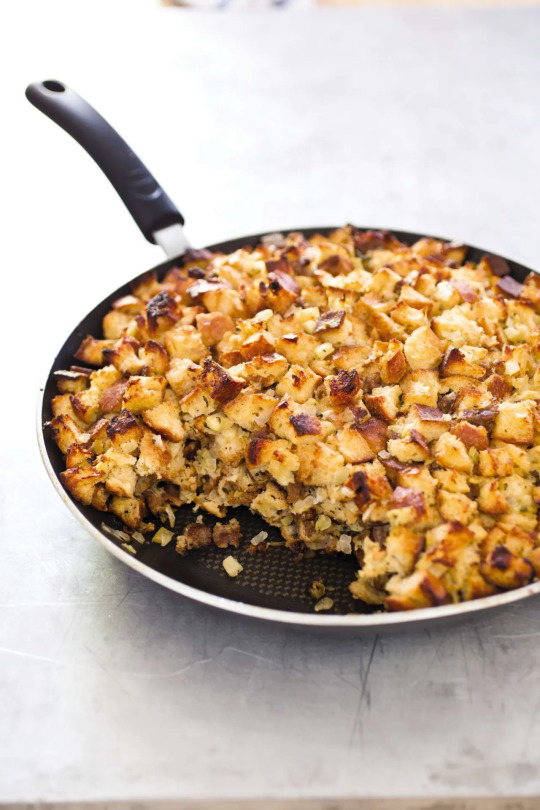
This stuffing has the traditional flavors of onion, celery, sage and thyme. It’s the crispy, crunchy texture that sets it apart. (Courtesy of America’s Test Kitchen)
The headnote says, “To maximize the crunchy, buttery portion of our holiday stuffing, we started by toasting bread cubes (we used a baguette for its high crust-to-bread ratio) in a hot oven, instead of simply drying them out. We then moistened the bread cubes in a mixture of chicken broth and eggs. We melted butter in a skillet, packed in the stuffing, and let it fry for a golden-brown bottom crust. Finally, we brushed the stuffing with melted butter and transferred the skillet to the oven to crisp up the top.”
Note: If your nonstick skillet doesn’t have a metal handle, wrap the handle in a double layer of foil before placing it in the oven.
Serves 8
Ingredients:
1 ½ pounds baguette, cut into ½ -inch cubes (18 cups)
3 ¾ cups chicken broth
4 large eggs, lightly beaten
8 tablespoons unsalted butter
2 onions, chopped fine
3 celery ribs, minced
1 ½ teaspoons salt
1 ½ tablespoons minced fresh thyme
1 ½ tablespoons minced fresh sage
3 garlic cloves, minced
¾ teaspoon pepper
Directions:
Adjust oven rack to upper-middle position and heat oven to 450 degrees. Arrange bread evenly on rimmed baking sheet and bake until light golden brown, 12 to15 minutes, stirring halfway through baking. Let the bread cool completely. Do not turn off the oven. Whisk broth and eggs together in large bowl. Stir bread into broth mixture until evenly coated. Set aside, stirring occasionally, to saturate bread. Melt 2 tablespoons butter in 12-inch, oven-safe nonstick skillet over medium heat. Add onions, celery, and salt and cook until browned, 10 to 12 minutes. Stir in thyme, sage, garlic, and pepper and cook until fragrant, about 30 seconds. Stir onion mixture into bread mixture.
Melt 3 tablespoons butter in now-empty skillet over low heat. Add stuffing to skillet, pressing firmly into even layer with spatula (skillet will be very full). Cook until the bottom of stuffing is browned around edges when lifted with spatula, 7 to 10 minutes. Melt the remaining 3 tablespoons butter in microwave and brush evenly over top of stuffing. Transfer skillet to oven and bake until center of stuffing is hot, and top is golden brown, about 20 minutes, rotating skillet halfway through baking. Let cool for 10 minutes.
Recipes courtesy of America’s Test Kitchen
Stephen Fries is professor emeritus and former coordinator of the Hospitality Management Programs at Gateway Community College in New Haven, Conn. He has been a food and culinary travel columnist for the past 15 years and is co-founder of and host of “Worth Tasting,” a culinary walking tour of downtown New Haven. He is a board member of the International Association of Culinary Professionals. Contact him at [email protected]. For more information, visit stephenfries.com.
0 notes
